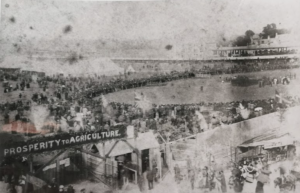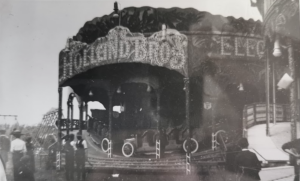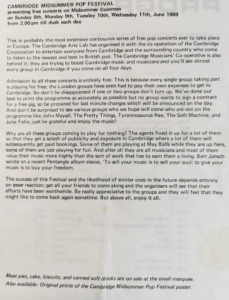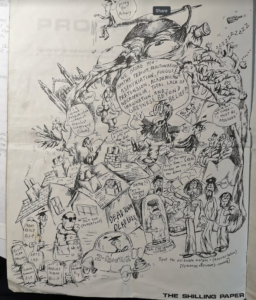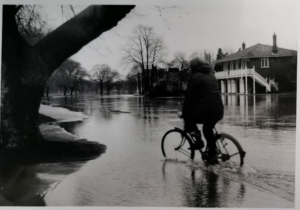Search by topic
- archaeology
- Building of Local Interest
- chapel
- charity
- church
- crime
- dressmaker
- fire
- Great Eastern Railway
- Listed building
- Mapping Relief
- medieval
- oral history
- poverty
- Public House
- Religious House
- Roman
- scholar
- school
- Then and Now
- tudor
- women
- work
- world war one
- world war two
Search by text
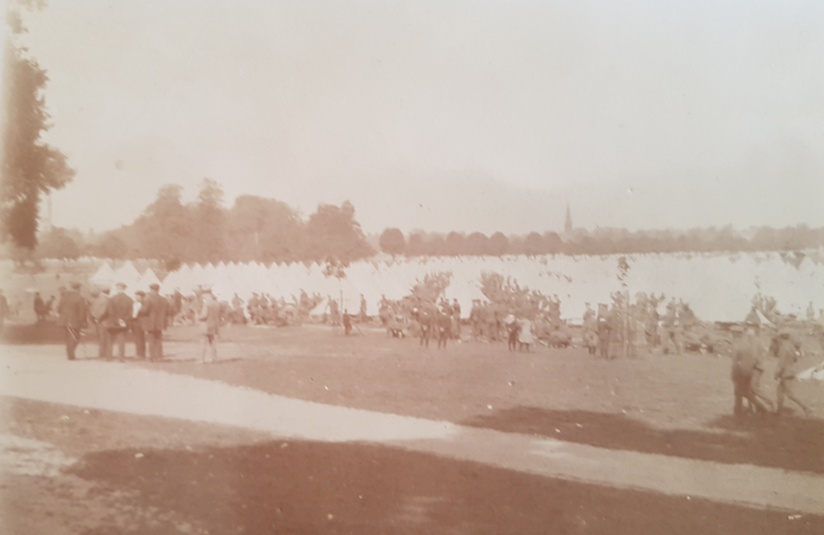 Camp on Midsummer Common 1914-18
Camp on Midsummer Common 1914-18Midsummer Common
History of Midsummer Common
There is a Wikipedia article about Midsummer Common:
https://en.wikipedia.org/wiki/Midsummer_Common
Bronze Age:
Gravel digging on Midsummer Common in 1860 revealed a Bronze Age vessel, possibly a funeral urn. A second vessel is certainly a food vessel. (p.38, C Fox, Archaeology of the Cambridge Area)

Bronze age pottery found on Midsummer Common (from Archaeology of the Cambridge Region, C Fox, CUP 1923)
A B Gray in Cambridge Revisited (1921) notes in reference to the 1603 outbreak of plague in Cambridge, that the entries in the parish registers of St Clements contain many references to the plague. The contemporary name for Midsummer Common was Grenecroft and several plague pits were dug there. Pits were dug there during the 1665 outbreak.
R Williamson in ‘The Plague in Cambridge’ (1956) notes that Midsummer Common was the site of the earliest plague huts / pest-houses. The dead would have been buried nearby. By the time of the 1665-6 plague such wooden huts were built on Coldham’s Common.
Josiah Chater records in his diaries frequent visits to Midsummer Common to see wild beast shows and circuses:
1844 8 Nov. ‘Van Ambury is building a large brick place on Midsummer Common for the keeping of his wild beasts and to show off his horsemanship.’
1845 Nov. ‘Wombwell’s wild beasts are on the Common.’
1847 14 May. Hylton’s menagerie was in town and had ‘ sent the elephant round this morning with a girl riding on its back’.
1847 Aug. Cook’s Riding Circus.
1884
1898
CDN 22 June 1900: Business was brisk, cart horses and nags forming the major portion of the stock. Buyers from many part of the country were at the fair.
1900
The Relief of Mafeking took place in May 1900. For more information about the siege follow this link.
The Cambridge Mammoth Show was held for the first time on Midsummer Common on August Bank Holiday 1904. In 1905 an attendance of 25,000 was reported; 1906 saw around 30,000. In 1906 there was a horticultural show, dog show, exhibitions of poultry, cats and mice, an athletics meeting as well as sideshows.
However, the event caused some controversy when the financial deficit was revealed the following year.
1909
1910
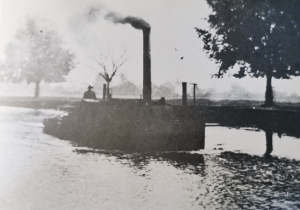
1910, Steam tug Olga at Midsummer Common. It towed two tank barges to carry gas water to King’s Lynn to be converted into fertilizer.
1911
William Barnard Rhodes-Moorhouse
1912

c.1912, roll call of Loyal Suffolk Hussars in Maid’s Causeway before setting off to camp at Lowestoft.

Annual horse and van parade, Midsummer Common on Whit Monday. Vans of Matthew and Son, 19 Trinity Street. (Starr & Rignall, unknown date)
1914-18
The Common was used as a military camp. Mrs Suttle (20 Victoria Avenue) recalled seeing Midsummer Common covered with the tents of the troops before they were sent to the front. (CWN 23.4.1981)
Arthur Gray, Cambridge Revisited: On the red brick wall skirting the western side of Butt’s Green, and still be seen (1920) sundry white numerals; and on each of the buttresses signs of iron staples, formed of old horse-shoes, having been torn away. Here, during that fateful winter of 1914-15, were the horse-lines of a regiment of the gallant 68th Welsh Division, who were billeted, it will be remembered, in the immediate neighbourhood pending orders from overseas. The dates and initials, may entwined with Cupid’s symbol, crudely scratched on this battered wall, inspire the hope that this impromptu war shrine may long claim respect from the passer-by.
1939
1939-45
The Suttles (see above) remembered tanks rumbling over Victoria Bridge.
1960s
Film of Chipperfield’s Circus on Midsummer Common. Film by Vernon Worrall Long and edited by his grandson, Gregory Long.
1964
Rag Day, November: The Seekers performed in a marquee.
1969 8 – 11 June, Free Pop Concerts
1974
Contribute
Do you have any information about the people or places in this article? If so, then please let us know using the Contact page or by emailing capturingcambridge@
License
This work is licensed under CC BY-NC-SA 4.0





